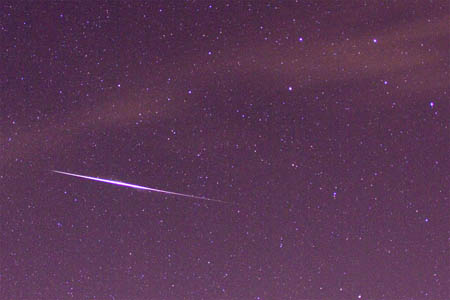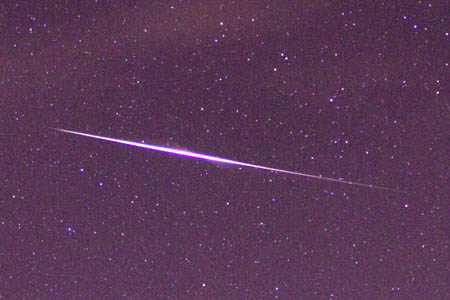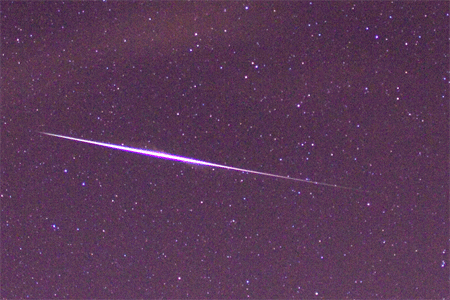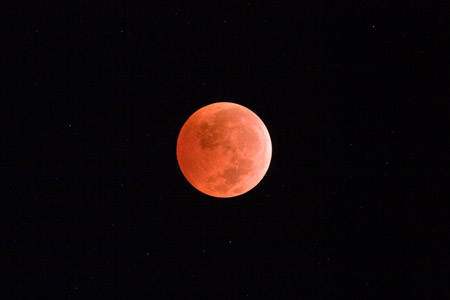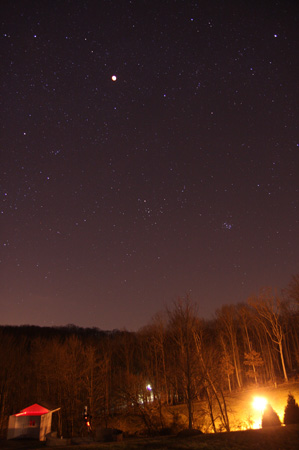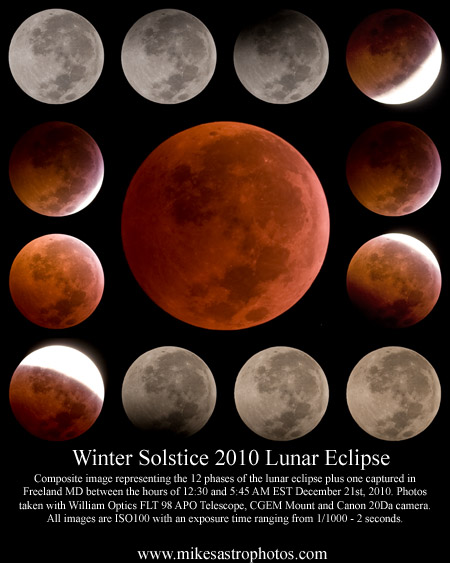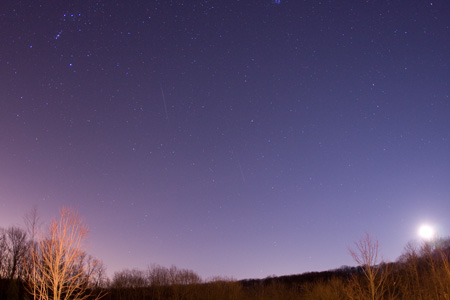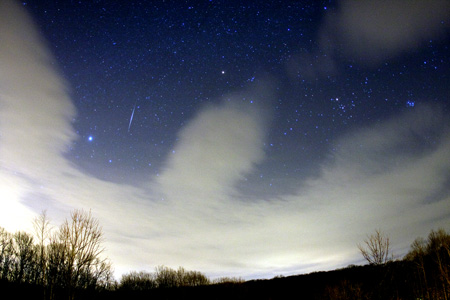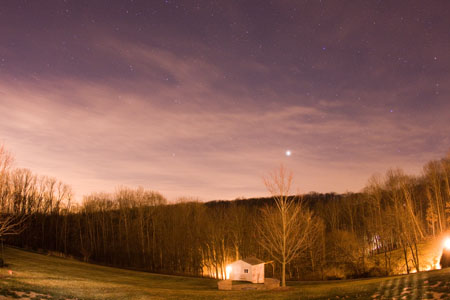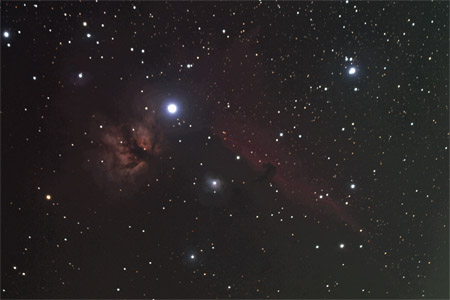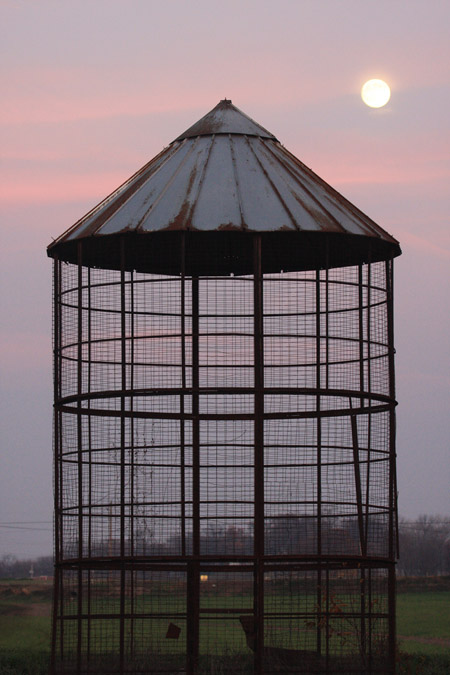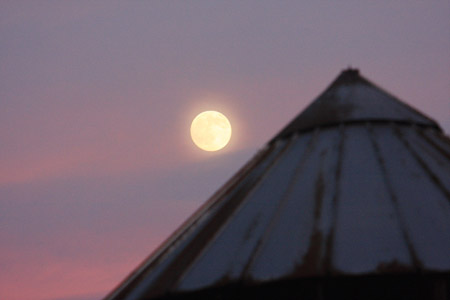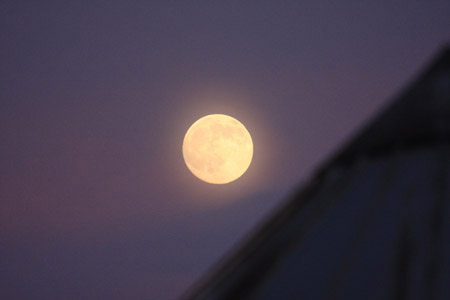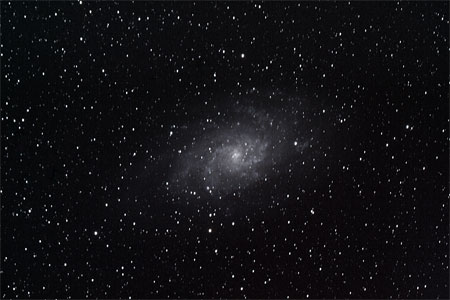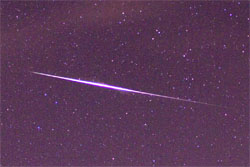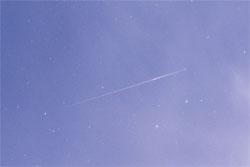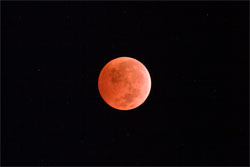Massive Fireball Meteor on 1/11/11
by Mike Hankey, under Comets & Meteors
According to Twitter, Facebook and AMS reports, a massive fireball was seen all over the south last night at approximately 8:40 central time. Fireball reports are coming in from Alabama, Mississippi, Texas, Arkansas, Louisiana, Tennessee, Oklahoma and Florida. Sonic booms were reported and early analysis indicate it was traveling south west to north east.
There have been NO photographs of this event yet. There have been 2 FAKES floating around though.
Last nights meteor probably looked like this:
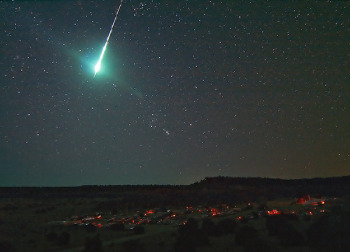
Photo By Howard Edin September 30, 2008
Here are some news reports.
http://www.katc.com/news/huge-fireball-spotted-over-southeast-us/
http://www.todaysthv.com/news/local/story.aspx?storyid=137947&catid=2
Early reports indicate it may have hit near, Poteau Mountain OK, but this has not yet been confirmed.
There are most certainly meteorites on the ground somewhere left behind by this cosmic visitor. The meteorite hunting community is already in rally mode. I would expect a meteorite is found within the next few days.
There is always a lot of mis-information spread when a fireball hits, so just to clear up a few things people have been writing in about:
1) no this is not the meteor apocalypse. Everything is ok, so don’t panic!
2) meteorites don’t burn green because of copper, they burn green because of nickle and iron.
3) this meteor was most certainly bigger than a pebble. Without being dramatic, it was at least the size of a basketball and could have been as big as a small car.
4) There is probably NOT a crater on the ground somewhere, but while the chances are extremely rare, this might happen.
5) Regarding terminology: its a ‘meteoroid’ when its in space; its a ‘meteor’ when it is in the sky on fire in Earth’s atmosphere; its a ‘meteorite’ when it hits the ground.
If you have any pictures or videos of this event, please email them to me. If you saw this spectacular event, please leave a comment and also report what you saw to the American Meteor Society.
I will update again with the AMS plots and possible trajectory asap, so bookmark and check back again soon.
Update 1/12/2010 – 12:56 EST – Here’s a surveillance video that captured the flash of the meteor, but unfortunately no direct sighting:
Two Tucson Arizona Fireballs
by Mike Hankey, under Misc
Within the last week two significant fireballs have been reported from Tucson, Arizona.
The first was on: 2011-01-08 @ 00:10:00 MST.
The second was this morning: 2011-01-11 @ 01:20:00 MST.
Here is a video from all sky camera that captured the 1/11/11 fireball:
You can see the fireball at the 7 second mark. This may have been a late Quadrantid?
Upcoming Close Asteroid Approaches
by Mike Hankey, under Misc
Be on the lookout for extra fireballs today and tomorrow. On January 11th, 2011 (tomorrow) 5 different NEOs (Near Earth Asteroids) will fly past Earth. There is an increased chance that fragments from these NEOs may hit Earth, creating large bright green fireballs. Have your cameras ready and please let me know if you see one.
1 AU = ~150 million kilometers
1 LD = Lunar Distance = ~384,000 kilometers
|
Object
Name |
Close
Approach Date |
Miss
Distance (AU) |
Miss
Distance (LD) |
Estimated
Diameter* |
H
(mag) |
Relative
Velocity (km/s) |
|
2011-Jan-11
|
0.0087
|
3.4
|
8.8 m – 20 m
|
27.4
|
5.56
|
|
|
2011-Jan-11
|
0.1588
|
61.8
|
200 m – 440 m
|
20.6
|
17.62
|
|
|
2011-Jan-11
|
0.0477
|
18.6
|
220 m – 480 m
|
20.4
|
7.86
|
|
|
2011-Jan-11
|
0.1710
|
66.6
|
100 m – 220 m
|
22.1
|
9.30
|
|
|
2011-Jan-11
|
0.0998
|
38.8
|
180 m – 390 m
|
20.9
|
7.42
|
|
|
2011-Jan-12
|
0.1801
|
70.1
|
310 m – 690 m
|
19.7
|
7.32
|
|
|
2011-Jan-13
|
0.1848
|
71.9
|
52 m – 120 m
|
23.5
|
6.58
|
|
|
2011-Jan-18
|
0.1823
|
70.9
|
18 m – 41 m
|
25.8
|
9.97
|
|
|
2011-Jan-20
|
0.1384
|
53.9
|
160 m – 360 m
|
21.1
|
15.77
|
|
|
2011-Jan-22
|
0.1647
|
64.1
|
110 m – 250 m
|
21.8
|
8.59
|
|
|
2011-Jan-22
|
0.1899
|
73.9
|
220 m – 490 m
|
20.4
|
17.30
|
|
|
2011-Jan-26
|
0.1628
|
63.3
|
490 m – 1.1 km
|
18.7
|
16.61
|
|
|
2011-Jan-31
|
0.1255
|
48.8
|
77 m – 170 m
|
22.7
|
8.75
|
|
|
2011-Jan-31
|
0.0948
|
36.9
|
24 m – 53 m
|
25.2
|
4.45
|
For more information please visit the NASA /JPL NEO site http://neo.jpl.nasa.gov/ca/
2011 Quadrantids Meteor Shower
by Mike Hankey, under Comets & Meteors
The 2011 Quadrantids Meteor Shower peaked this morning at 1:00 a.m.
I took photos last night continuously from about 8:00 PM till dawn and only caught one meteor, but it was a good one.
Here’s the meteor at full resolution:
To see the full shot, click here.
The cool thing about it is, the meteor left behind a visible smoke trail that showed up in 20+ consecutive frames after the flash. That’s more than 10 minutes! Its hard for me to say for sure, but I think this may have been a fireball.
Here’s an animated sequence of about 10 frames that shows the smoke trail left by the meteor.
This shower will be active until January 10th and with all the fireball activity happening lately, it is worth checking out!
Photo Details
Canon 50d DSLR
25 Seconds @ ISO 800
Canon EF 15mm f/2.8 fish eye lens
Mounted Piggy Back to CGEM
UPDATE: 1/4/2010
As I was driving home today I realized that I would have probably caught this picture on one of my new security cameras. I knew the exact time was 2:43, so when I got home I checked the video log. Sure enough, I just barely caught it at the edge of the screen.
Look in the center top of the video to see the fireball at the 2 second mark. You may need to replay the video a few times to get it.
Update on 12/28/2010 & 12/29/201 East Coast Meteors
by Mike Hankey, under Comets & Meteors
On 12/29/2010 a second meteor shot through the skies west of Maryland at 8:30 PM. This made for an exciting week and is causing some confusion with peoples observations. Two big fireballs in the same location 26 hours apart is certainly an odd coincidence. Reports of the 12/28/2010 meteor touching down in Fredrick and being found are most certainly FALSE.
Tuesday night’s meteor (or meteor #1) was captured on video by York Water Company. That makes at least 3 significant meteors captured by York Water in about 18 months. Here is the latest York Water video:
Tuesday night’s meteor is looking to have touched ground somewhere in South Central Pennsylvania. We are not sure just yet where Wednesday night’s meteor landed, but it was somewhere West of Freeland MD. I’m working on the AMS plots for both events, but won’t have these together for a few more days.
All these meteor falls sure are exciting, but guess what… Not one of the 6 meteors that have flown across the Maryland skies since July 6th, 2009 has come even close in size to the Mason Dixon Meteor. Nation wide, there has not been a single report of homes shaking to the level that the MDM caused since July 6th 2009. The closest was Wisconsin which resulted in 100+ meteorite finds, but even Wisconsin did not shake homes like the MDM. These facts are encouraging for those still searching for the Mason Dixon Meteor.
December 28th, 2010 – Pennsylvania Fireball
by Mike Hankey, under Comets & Meteors
Reports are flying in regarding a fireball seen over Pennsylvania at 6:45 PM EST. Witnesses from South Carolina to Massachusetts are reporting a large bolide flying from south east to north west. Over 50 witness reports have been submitted to the AMS already. Early plotting suggests Michigan as the termination point. Will update on this event as more information becomes available. If you saw this fireball please report your sighting to the American Meteor Society Fireball Page.
Lunar Eclipse – December 21st, 2010
by Mike Hankey, under Lunar
Today was a special celestial day here on Earth. In addition to it being the winter solstice there was also a total lunar eclipse. These two events had not coincided together in 372 years. I had been looking forward to the eclipse for several months, hoping for good weather and planning out my strategy to photograph the event. Photographing eclipses and timing everything just right can get a little tricky and having never done it before, I wasn’t sure what to expect.
I started to research and quickly learned I would need to baby sit the camera through the entire process (a 5 hour tour). As the eclipse progresses and regresses, the moon significantly looses light and gains it back and thus the camera exposure times need to be adjusted throughout the night. I was able to find a nice chart that illustrated the formula to determine exposure times in a lunar eclipse. I also found a time schedule for the different phases. I used these two documents together as a guide for adjusting my exposures, starting out at 1/1000 of a second for the full moon and working my way up to 2 full seconds for the totally eclipsed moon. We had a few intermittent clouds through out the night, but they didn’t last long. All in all it was a perfect evening and I couldn’t have asked for more.
Here’s a nice photo of phase 9 of the tail end of the eclipse. Its a combination of two exposures, one short to capture the detail on the illuminated surface and another long to catch the red hue of the eclipsed side. Blending the two frames together ads definition to the bright part of the moon and makes an interesting effect.
I set up my second camera with the fish eye lens to photograph the evening, hoping we might get lucky and catch a meteor during the eclipse (that didn’t happen). It was really cool to see the difference in the sky when the moon was eclipsed.
The period of totality was calm, serene and surreal. It got so dark, the stars came out like a moonless night. At the end of the show I had a nice collection of images that documented the entire process. I had programmed my cable release to take a picture once every 20 seconds throughout the night and did this continuously from 12:30 – 5:45 am. I set alarms on my iphone to alert me with every phase change and at those points adjusted the exposure times up and down. I also had to periodically correct the tracking as my alignment wasn’t perfect and I wasn’t auto-guiding. There were times through the process where I would take multiple exposures, one short and one long. This would capture both the black gray and white red effects at the same phase of the eclipse. Both styles of these pictures are cool and both are available to the photographer throughout the process. If I had to do it over again I would have taken advantage of this more and manually switched the times more often.
I spent a good bit of time sifting through the images and thinking about the best way to present them. There are so many cool pictures throughout the entire process, but I can’t really post dozens of pictures on the site. I pulled out the key frames / phase change moments and went from there. I made an animated gif of the eclipse and thought about making a time lapse movie. Then this final design idea came to me, I sketched it out on a post-it note, liked the symmetry and wiped it together in photoshop. I think it might make a nice postcard.
Here’s a composite image representing the 12 phases of the lunar eclipse.
This was really a great experience and it worked out better than I could have hoped. There are a few improvements I will make in 2014, and I’m looking forward to it already.
Double Geminid
by Mike Hankey, under Comets & Meteors
Over 2 nights of mostly cloudy weather I was able to capture 21 total meteor photos (out of 2000+ images). One of these exposures caught two meteors within the same shot (a 25 second time frame).
Photo Details: Canon 40d camera with Canon EF 15mm f/2.8 fish eye lens; 25 second ISO 800 exposure
Geminids 2010
by Mike Hankey, under Comets & Meteors
The Geminid Meteor Shower peaked before dawn this morning and observers around the globe are reporting one of the best showings in years boasting rates of over 100 meteors per hour. The east coast and much of the country was under clouds and snow storms. I setup my camera while it was cloudy hoping conditions might change. Fortunately between 2:30-4 am the clouds cleared up a bit and in that 1.5 hours I photographed 13 meteors. Its cloud tonight, but I’m trying the same plan again. Here’s one of the photos from last night. I’m still processing the other pictures and will post more later.
Jupiter over Observatory
by Mike Hankey, under Planets
I got a new wide angle fish eye lens specifically for photographing the Geminids. The peak would be Tuesday morning and the weather report for Maryland looks like a whole lot of clouds the next few days. I was thinking about packing it all up and going for a road trip…
Here’s a shot through the new Canon EF 15mm f/2.8 fish eye lens. The big bright light over the observatory is Jupiter. I can capture more than 2x as much sky with this new lens compared to my next best meteor lens, hopefully that should lead to 2x as many meteor photos.
Geminid Meteor Shower This Week
by Mike Hankey, under Comets & Meteors
The Geminid Meteor Shower, one of the best showers of the year peaks this Tuesday right before dawn. If you have clear skys this weekend and over the next few days take time to look up for a few hours.
http://www.usatoday.com/tech/science/2010-12-10-geminid-shower_N.htm
The Horse Head Nebula
by Mike Hankey, under Nebula
The Horsehead Nebula is found on the left side of Orion’s Belt, near the star Alnitak. It is difficult to see with the naked eye through a telescope, but on a long exposure it can be a remarkable sight.
Photo Details:
William Optics FLT 98 / CGEM Mount
Canon 20Da Camera
SBIG STV Autoguider
20×5 minute ISO 400 exposures
Deep Sky Stacker
Photoshop cleanup
Beaver Moon in Lancaster
by Mike Hankey, under Lunar, Mason Dixon Meteor
The November full moon is known in the farmers almanac as the Beaver Moon. This was a signal to let people know to set their beaver traps before the creeks froze. The Full Beaver Moon also comes from the fact that beavers are actively preparing for winter at this time of year.
I caught some nice pictures of the Beaver Moon while meteorite hunting in Lancaster PA.
Reddit, Am I doing this right?
Breaking News: Fireball in Baltimore MD and York PA Nov 12, 2010 8:30 PM
by Mike Hankey, under Comets & Meteors
I was on my way home from meteorite hunting when I got a call from a neighbor in Freeland MD. He said he had just witnessed a huge fireball from the south-south-east headed to the north. The time was 8:30 on November 12th. He said it left a trail across the sky that stayed illuminated for several seconds after the meteor passed. It was bright enough to lighten the ground of the deck where he was standing. Based on his report it sounds like it would have started over Baltimore MD and ended in Harrisburg PA. I will post more information as it becomes available. Any witnesses to this event are encouraged to submit their account to the American Meteor Society Fireball Report.
M33 – Triangulum Galaxy
by Mike Hankey, under Galaxies
Approximately 3 million light years away in the constellation Triangulum is a spiral galaxy called The Triangulum Galaxy. Catalogued as Messier 33 or NGC 598,it is sometimes icalled the Pinwheel Galaxy, a nickname it shares with Messier 101. The Triangulum Galaxy is the third-largest member of the Local Group of galaxies, which includes the Milky Way Galaxy, the Andromeda Galaxy and about 30 other smaller galaxies.
Photo Details:
William Optics FLT 98 / CGEM Mount
Canon 20Da Camera
SBIG STV Autoguider
12×5 minute ISO 400 exposures
Deep Sky Stacker
Photoshop cleanup
